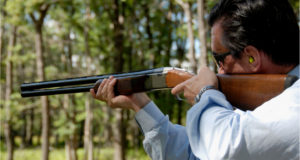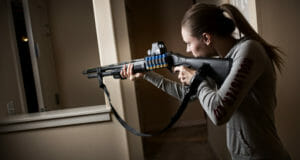|
Listen To The Article
|
 For many shooters, it’s a ritual to pack the range bag and head off to the shooting range. Shooting ranges are great places to, well, send rounds downrange. You show up, unpack your things on the little bench, pull out your weapon, break out into your favorite weaver or isosceles stance, and fire off a few dozen rounds. At the end of all that, you pack it all up and head home. Rinse, repeat.
For many shooters, it’s a ritual to pack the range bag and head off to the shooting range. Shooting ranges are great places to, well, send rounds downrange. You show up, unpack your things on the little bench, pull out your weapon, break out into your favorite weaver or isosceles stance, and fire off a few dozen rounds. At the end of all that, you pack it all up and head home. Rinse, repeat.
There are some serious problems with shooting like this, however. Months, years, or even a lifetime spent range shooting really limits you as a tactical shooter. You might think you’re honing your shooting skills – and to some degree, you are. Trigger squeeze, breath control, grip, and stance can all be extremely finely tuned by putting in some serious range time. There are some areas that atrophy badly on a range, however – and these are areas you may not have even learned to begin with!
Not The Optimal Choice
Consider that the basic design of most shooting ranges – especially indoor ranges – is primarily centered around the concept of shooter safety rather than effective shooting. Many ranges place shooters very close together, separating them from each other with dividers. Most shooters will fire their weapon within a very narrow box, almost like having blinders on. Consider the average range for a moment:
- Comprised of a bunch of shooting stalls packed into close quarters.
- You’re only allowed to shoot targets in your lane.
- You’re usually only allowed to shoot from a standing position.
- Drawing from a holster is usually discouraged or prohibited.
- The elevation of the target remains constant.
Keep Your Handgun Locked and Loaded, Ready For Instant Use – Without Fear Of An Accident!
Realize that all of the above limitations are there for one thing, and one thing only – shooter safety. That’s great when you fill a large room with a bunch of armed strangers, but you’re really missing out on learning some fundamental shooting skills! If you’ve never learned those skills, you’re missing a whole dimension of shooting. What skills are we talking about? How about:
- The close quarters of a range puts you right in the middle of lots of armed people and lots of loud gunshots going off around you. If you’re vigilant (you are vigilant, aren‘t you?), you don’t spend most of your time concentrating on your lane – instead, you‘re keeping a close eye on the yahoo beside you trying to impress his girlfriend rather than watch his muzzle.
- Being only allowed to shoot targets in your lane essentially makes you a perpendicular shooter. You’ve never shot targets at oblique angles or from anything other than dead on!
- Shooting from a standing position is fine, but realize that in a tactical situation you might be shooting from anything but a standing position. Have you ever shot prone? How about supine (on your back)? How about kneeling, or even behind cover? Have you ever shot under a car? How about flat on your side behind a rock? These are all positions of cover, and cover is essential in a gunfight.
- Drawing from a holster is an essential skill if you carry a firearm for a living. Even if you have a concealed license, you need to practice your draw. You aren’t going to be walking around with a handgun in your hand all the time, are you?
- Target elevation is important. Most range targets are conveniently placed at “normal guy height,” for lack of a better term. But what about shooting at someone in a second-story window? Or shooting down a hill at an attacker? Elevation is much more than just man height. You need to be flexible.
Where Can I Practice These Skills?
Consider heading off to some local Bureau of Land Management (BLM) land once in a while. These are federal lands that one can usually hunt and almost always shoot on. There are many designated shooting areas nationwide that are nice, wide-open, and rugged pieces of land. Many of these contain canyons and other features, giving them a natural backstop for lead. Surprisingly, most BLM land is almost always devoid of people, so you can pretty much practice whatever you want. Want to hide behind a rock and return fire at an invisible target? Go ahead—give it a try. Want to try shooting through your legs? Go for it. Want to actually shoot and move at the same time? You won’t get that at most ranges.
Shooting on BLM land doesn’t mean you throw safety out the window – quite the opposite. You must teach yourself to be safe while operating a handgun or rifle in a much more dynamic mode than you are probably used to. Shooting outdoors is as realistic as it gets! You might be a great range shooter, but spend some time outdoors honing your lesser used dynamic shooting skills and you’ll quickly see how much better of a shooter you can become.
 Off The Grid News Better Ideas For Off The Grid Living
Off The Grid News Better Ideas For Off The Grid Living




